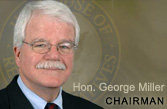






Press Releases
Democratic Lawmakers Release Final Legislation to Make Single Largest Investment in College Aid Since GI Bill
|
||
|
Wednesday, September 5, 2007 |
||
|
WASHINGTON, DC -- U.S. Rep. George Miller (D-CA) and U.S. Senator Edward M. Kennedy (D-MA) today released final legislation that would make the single largest investment in college financial aid since the GI Bill of 1944 – helping millions of students and families pay for college at no new cost to taxpayers. The legislation, the College Cost Reduction and Access Act, would boost college aid by roughly $20 billion over the next five years. The legislation pays for itself by reducing excessive federal subsidies paid to lenders in the college loan industry. It also includes $750 million in federal budget deficit reduction. “This bill will do more to help students and families in this country pay for college than any effort since the GI Bill,” said Miller, the chairman of the House Education and Labor Committee. “With this bill, the Democratic Congress is delivering on our promise to make college more affordable and accessible for all qualified students. I urge the President to join us in this historic investment in our students – and our future – by signing this bill. There is no smarter policy – or greater priority – than helping all students afford to get a good college education and pursue their dreams.” “College education has become more important than ever. By making college more affordable for young Americans, we not only open doors of opportunity for them, but we equip a new generation of Americans to compete and win in the global economy,” said Kennedy, the chairman of the Senate Health, Education, Labor and Pensions Committee. “Just as the GI bill half a century ago, this bill increases access to higher education for millions of Americans.” Under the legislation, the maximum value of the Pell Grant scholarship would increase by $1,090 over the next five years, reaching $5,400 by 2012, up from $4,050 in 2006, thus restoring the Pell’s purchasing power. Some students would see an immediate boost of almost $500 in their Pell Grant scholarship in the 2008-2009 school year alone. Roughly 5.5 million low- and moderate-income students would benefit from this increase. · Making loan payments more manageable for students; · Providing tuition assistance for excellent undergraduate students who agree to teach in high-need subjects in high-need schools; · Making a landmark new investment in minority serving institutions, including Historically Black Colleges and Universities and Hispanic Serving Institutions, for critical support services that help recruit and retain students; and · Encouraging and rewarding public service by providing loan forgiveness for college graduates that go into public service professions, such as military officers, first responders, firefighters, nurses, law enforcement officers, prosecutors, early childhood educators, public defenders, librarians, and others. The College Cost Reduction and Access Act combines elements from House and Senate bills that were passed in July. The agreement was negotiated and approved by Miller, Kennedy, and a conference committee comprised of House and Senate lawmakers. If approved by Congress, the bill would then go to the President for his signature. President Franklin Roosevelt signed the GI Bill into law in 1944. The original law enabled 7.8 million veterans of the second World War to participate in education or job training programs. For a fact sheet on the legislation, click here.
FOR IMMEDIATE RELEASE |
2181 Rayburn House Office Building | Washington, DC 20515 | t: 202-225-3725
Site Map | Privacy Policy | Contact Us | Minority Site